Is thuja a coniferous or deciduous tree?
Thuja - an evergreen plant of the cypress family. It belongs to conifers, but instead of needles, it has soft scales.
Content:
- Description of the plant
- Reproduction methods
- Planting a thuja seedling
- Care advice
- Preparing for winter
- Pests and problems in cultivation
Description of the plant
In total, 5 species of thuja are known in nature. But in our area, thuja western has taken root and is widespread. It grows everywhere except the far north and south. In the southern regions, folded thuja is found. It grows in natural conditions up to 70 m, but breeders have bred low varieties that are used in landscaping.
The homeland of the western thuja is North America. On the basis of this type of thuja, more than 100 varieties have been created, which differ in the shape of the crown, which can be:
- Pyramidal
- Columnar
- Spherical
- Weeping
Thuja can look like a tree or a bush, the height of which does not exceed 5 m. There are also low varieties, representatives of which reach a height of 1 m. The crown of thuja is compact. The bark of the trunk is brown with a red tint. The needles are bright green in spring and summer, in winter they acquire a brown hue. There are varieties with red or variegated scales.
Popular varieties:
- Brabant is a tree up to 7 m high and up to 3 m wide. The crown shape is columnar. It is appreciated by gardeners for its active growth, which is 30 cm per year. Green needles do not lose their color in winter.
- Smaragd reaches 5 m in height. But it does not grow quickly, 10 cm per year. The shape of the crown is pyramidal. In width it reaches 1.5 m. It is a very hardy and undemanding variety to growing conditions.
- Hoseri is a short, round bush. The maximum height of the bush is 0.5 m. It looks original against the background of tall trees, it is used for landscaping small areas.
Reproduction methods
Tuyu is propagated by:
- Seeds... The propagation of thuja by seeds is rarely practiced by gardeners, not only because it will be possible to grow a tree only after 5 years. Most likely it will be a little like the mother plant. Indeed, when propagated by seeds, these properties are transmitted only in some cases. But such bushes will not freeze slightly, they will adapt well to the climate. Seeds for growing thuja are taken fresh and stratify them. It is best done under snow, but can be mixed with sand and taken to a cold cellar. In the spring, a loose nutrient soil is prepared, seeds are placed on its surface. Sprinkle them with a layer of earth 1 cm thick. To prevent them from drying out, mulch the plot with coniferous sawdust. It is better to grow thuja seedlings in partial shade. So they will not be afraid of direct sunlight. Shoots appear quickly. They need to be looked after: moisturized, protected from direct sunlight. Once a month grown seedlings are fed organic fertilizers in low concentration.
- Cuttings... Propagation by cuttings makes it possible to get young thuja faster. For this, two-year-old shoots up to 30 cm long or annual 15 cm long are used. Tear them off so that a piece of bark remains at the end of the shoot. Preference is given to cuttings cut from the top of the bush. They better retain the qualities of the mother bush. The operation is performed on a cloudy day or early in the morning. Cooked cuttings are processed first potassium permanganate solution for disinfection, then root root for active callus formation. Prepare a greenhouse with a loose nutritious soil. Install the prepared cuttings at an angle, deepening by 5 cm. Cover with foil. Maintain high humidity at all times. Young thuja are transplanted in early spring.
- Saplings. The easiest way to buy a seedling is in special nurseries. There are grown seedlings of zoned varieties that are resistant to diseases and pests. When buying a seedling, they look at the state of the earth lump, needles and the general appearance of the plant. The soil should not be overdried, the needles should sit firmly on the shoots and not crumble. After the purchase, the seedling is watered, set in a shaded place and planted on the same day.
Planting a thuja seedling
Thuja can grow almost anywhere. But under the scorching rays of the sun, it burns out and dries up, as a result of which it gets sick more often, it can freeze in winter. But even in the shade, she will not look beautiful. It will lose its splendor, stretch out, the color of the needles will change and fade. Therefore, it is better to choose a place for her, slightly shaded from the sun and protected from the wind.
It is better to plant thuja in spring, but a shrub with a protected root system can be planted throughout the growing season.
A pit is prepared with a depth and width of at least 80 cm. Ground mixed with mineral fertilizers is laid on the bottom. The remaining soil is mixed with sand. Set the root collar flush with the ground. If it is under the soil, it can rot during watering. If it is high above the soil level, it may dry out.
The distance between the bushes depends on their variety. For low spherical plants, 50 cm is enough, for the Brabant variety, it must be increased to 5 m. When forming hedges, a distance of 1 m is left, regardless of the thuja variety.
The pit is filled up, watered, bringing in 1-2 buckets of water. Mulch the soil in the trunk circle. You can do this not only with ordinary peat or sawdust... But also with beautiful crushed bark of different shades. Such mulch will not only protect against drying out, but also decorate the site. After planting, the thuja is watered with Zircon. It stimulates root formation, helps the roots to better absorb useful elements.
Care advice
How to properly care for thuja:
- After planting, the thuja is watered. The soil under it should not dry out. Therefore, once a week, add a bucket of water. Not only the color and quality of the needles depends on the moisture content of the soil, but also the number of cones, which only spoil the appearance of the bush. If the soil is dry, there will be more buds. The tops of the shoots begin to dry out, the plant loses its decorative appearance. Water the thuja early in the morning or in the evening. At the same time, sprinkling is carried out, which has a positive effect on the appearance of the plant.
- The trunk circle of thuja is kept clean, removing weeds. Shallow soil is loosened to provide air access to the roots, but at the same time not to damage them. If the trunk circle is protected by mulch, you do not need to remove it and loosen the soil.
- Thuja is fertilized once a year in spring. They bring humus compost, fertilizers for conifers, bought in the store. Frequent feeding is not necessary. This can lead to faster growth, as a result, the bush will need to be pruned more often. Thuja is not fertilized in autumn, because young branches will not have time to ripen and will die in winter.
- The first planned pruning of the crown begins in the third year after planting. The bush can be given a variety of shapes: a ball, a cone, a cylinder, or combinations thereof. You can shorten the shoots by no more than a third of the length. Use a high-quality and powerful pruner that cuts off the ends of the branches, rather than crushing them. When forming hedge cut off the top horizontally. Pruning is carried out at the beginning and at the end of summer. Dry and damaged branches are removed all year round.
Preparing for winter
In the southern regions and in the middle lane, thuja winters without shelter. Mulching the root system with a thick layer of humus or compost will not hurt her.In the northern regions, thuja is also grown, but for the winter it needs to be protected and sheltered from frost. Water abundantly in autumn. For the first 2 years for the winter, they wrap the bush with spunbond or put on special covers for wintering plants.
It is important that the protective material allows light to pass through. This will allow the processes of photosynthesis to take place in winter, which do not stop all year round.
You need to remove the shelter after the ground under the bush thaws to the depth of the shovel bayonet. They are freed from shelter in cloudy weather so that the sun's rays do not damage the needles. If you remove the shelter before the soil warms up, this will lead to the rapid growth of young branches in the sun. The root system will not have time to supply them with moisture and nutrients.
Older plants do not completely cover, but protect its branches from wind and snow. To do this, they are entwined with ropes and pulled closer to each other, but so as not to break off. In winter, after a snowfall, they shake off the snow from the bushes. If this is not done, the needles inside the bush on the pressed branches can become moldy.
Pests and problems in cultivation
If the thuja has turned yellow in the spring, you need to determine the reason. It could be sunburn. It can appear even when using a spunbond that transmits ultraviolet light. Therefore, the bushes wrapped in it can be additionally protected from the sun, starting in February.
The needles may darken if very dense materials are used for covering. This leads to the formation of a greenhouse effect. The needles rot and turn black or yellow. If this happens, water the bush with warm water and spray it with Ecogel-Antistress. Later, in early summer, during pruning, the damaged branches are cut off.
If water has collected in the area where the thuja grows and is not absorbed into the ground for a long time, its root system can rot. If the water has not been standing for long, they slightly loosen the soil, improving its ventilation. The bush is treated with antifungal drugs. Sprayed with Zircon to accelerate growth and protect against fungus.
If the groundwater is constantly very close to the soil level, it is better to transplant the bush to another place.
Thuja can turn yellow from the action of pests. The appearance of yellow ulcers on the shoots indicates the presence of a thuja false shield. They are treated in early spring with Bordeaux liquid, in summer and during the growing season - Oxyhom, Aktellik.
More information can be found in the video:



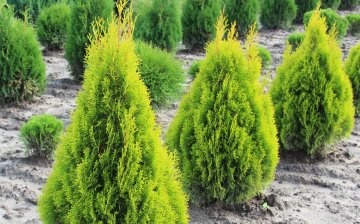


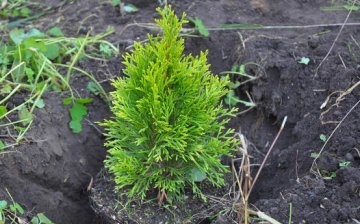
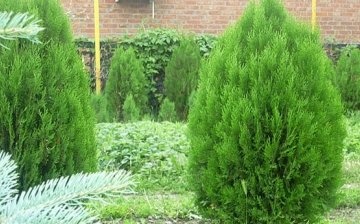

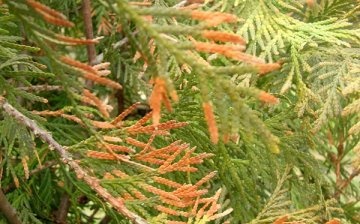







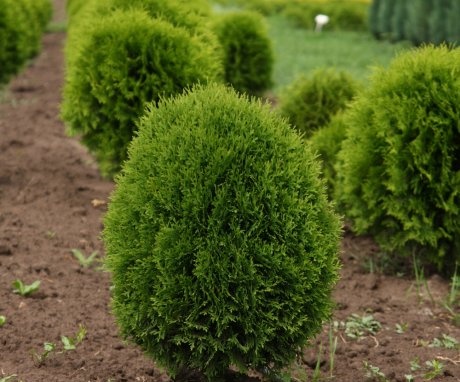

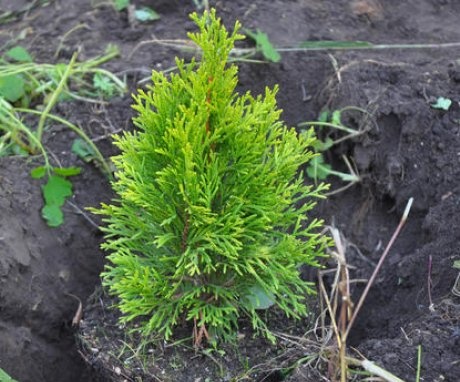
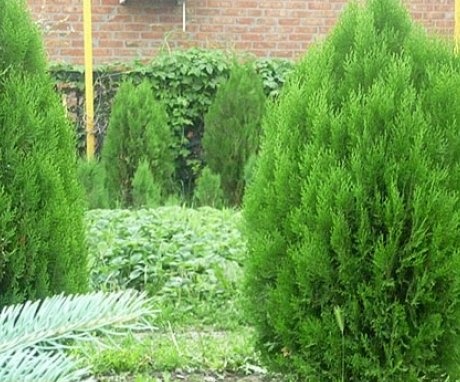
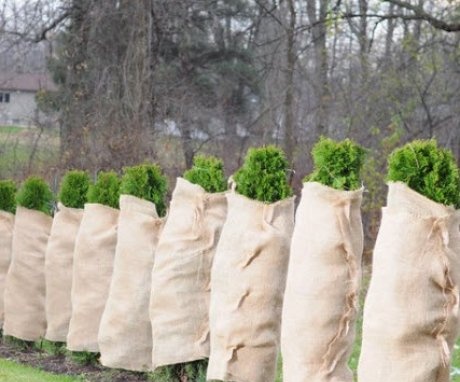
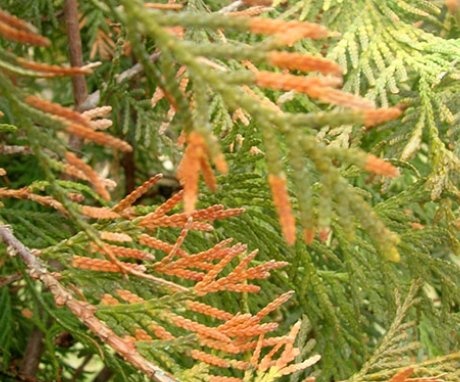
Thuja is a fairly beautiful tree and does not need special care. But I would not grow it from seeds, I tried it many times, the trees grown from seeds turn out to be some kind of weak and stunted.